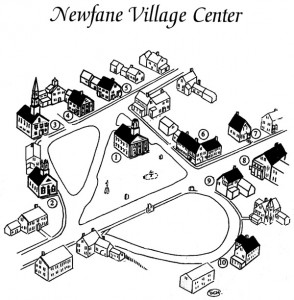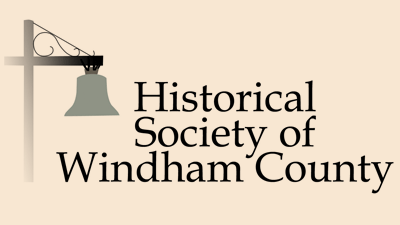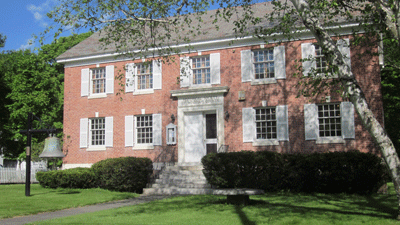Newfane Village in the Town of Newfane
The Village of Newfane was founded in 1774 on Newfane Hill a couple of miles southwest of here. Within a few years there were twenty houses, a court house, an academy three stores, two hotels, a meeting house, various repair shops, a jail, and a whipping post.
After a certain amount of maneuvering the Town of Newfane became the shire town in 1787 (i.e. the county seat), and in 1825 the hardy citizens moved their village down off the hill to the flats around Smith Brook where there were only a few houses. They took some of the buildings apart, brought them down on ox sleds and put them up again. (Among these were part of the present Newfane Inn and the two houses just south of the church.) But mostly they had to build anew and in that first year a small general store quickly appeared where the Newfane Store now stands, while the county erected a brand new court house and a jail at a cost of $10,000. A meeting house went up in 1832 (now the Union Hall) and a few years later the Congregational Church. During the next decade houses went up one after another on Pleasant Street (now West Street) and Main Street (Route 30); so that the village you see now was mostly in place by 1850.
As the nineteenth century waned, the changes began. The telegraph was put through in 1878, soon followed by the 36 mile, narrow-gauge Brattleboro & Whitehall Railroad. Newfane now had a railroad station (still intact on Depot Street) when the first train came to town in 1880.
About the turn of the century, legend has it, the first bathroom came to town. It was successfully installed in the Tower House (sixth house north of the Four Columns Inn). However, as soon as the owner found he was in for a tax increase on his house because of the improvement, he pulled out the pipes and nailed the door shut.
In the early 1900s Benjamin Eager, living right across the street, put in the first telephone. ”Central” was ensconced in the building at the corner of West and Court Streets. Central worked long hours and was supplied with a couch where she could curl up for a nap when things were slow. Often however, the circuit was overloaded and Central would tell a person trying to make a call, “Busy now. We’l1 call you back.” This happened to George Read and he was so exasperated he drove up to South Wardsboro and delivered the message in person. About an hour after he got back his phone rang and Central said,”We are ready for your call now.”
John D. Pierce the clockmaker and undertaker had the first automobile, a Nash Rambler. His license plate number was VERMONT 188. The year, 1909. By the teens there were many cars, but people had to put them up before freezeup because frozen ruts in the roads played havoc with the tires.
By 1912 there were two street lamps to illuminate the space in front of the present Country Store and the horse trough. Fired by gasoline, they were hauled up every night on ropes. Then electricity arrived in 1913.
So the old was giving way to the new. The automobile put the railroad out of business by 1936 and the dusty, grass-bordered carriage roads soon gave way to gravel and tar. Farms disappeared one by one, until the last sizeable farming operation in Newfane gave up in the 1970s.
Those sturdy people and their lifestyle are gone forever, but what they built is still here for us to enjoy.
Newfane Village Center Tour

1. Windham County Court House: 1825, 1853, 1907.
One of the jewels of New England architecture. Originally the Court House was a Federal-style, box-like structure, its roof pierced by four chimneys. In 1853 the porch and four beautiful Doric columns that were added produced its Greek Revival aspect. In 1907 the building was further enlarged at the opposite end. Court sessions are held here, and have been for the last hundred and sixty years.
2. Union Hall: 1832.
This meeting house was built by a group of “liberal and charitable” Christians as a center for religious freedom and worship by all sects that contributed to the cost. The contract price was $1600, but there were a few extras: $14.50 for alterations and $12.00 for a lightning rod. After twenty years it was abandoned, then converted to a public hall in 1872. It is now used for meetings, weddings, concerts, movies, auctions, etc.
3. First Congregational Church (Church Street): 1839.
The Congregational group soon became dissatisfied with their meeting house (now the Union Hall) as their place of worship; so they raised $4000 and erected a church to accommodate three hundred people. Like so many New England churches it emulates in wood those built of stone by the English architect, Sir Christopher Wren. The decorative features are Greek Revival, but with a Gothic Revival overlay that was added later. (Note the pointed-arch windows and shutters.)
4. Kimball-Benedict House (West Street): 1832 Four Columns Inn: 1969.
This beautiful house, the outstanding example of a Greek Revival dwelling in the village, was built for General Pardon T. Kimball (1797-1873). Situated behind the Court House, its four handsome Greek columns echo those of the county building. Above them, behind, a balustrade, is the balcony which was once a flower conservatory. In 1969 the house and accompanying barn, having been renovated, became the Four Columns Inn.
5. Moore Free Library (West Street): c. 1840, 1897-1989.
The tiny original house, built within a few feet of Pleasant Street (now West Street), was shown as “Tailor Shop and Post Office’ in 1856. Forty-two years later Mrs. Philura C. Moore, widow of a well-to- do drover more than doubled its size and turned it into a library for the townspeople to use.
6. Newfane Irm (Main and Courts Streets): 1787, moved 1825.
The Federal-style corner section was brought down from Newfane Hill by the town’s first developer, Anthony Jones. (Notice the beautiful semi-elliptical fanlights over the main entrance and over the fihe doorway facing Route 30.) The building has been an inn more or less continuously since it was first built, and after World War II was painstakingly restored by the world-famous decorator, Christopher S. Castou.
7. Chittenden Bank, formerly Windham County Savings Bank (Main Street): 1884.
Newfane’s only example of the late nineteenth-century Romanesque style, popularized by the renowned architect, H. Richardson. It was designed by George A. Hines, and built for $6650. The bricks were brought in by ox cart. Those for the front cost 5 cents apiece; those for the sidewalls 3 cents; and those for the back wall 2 cents. Inside some of the old features remain, among them the butternut counter and the metal screen surmounting it.
8. Former Higgins Store and Post Office (Main and Depot Streets): 1876.
About 1840 Anthony Jones built here the largest structure the village ever had, the Jones Exchange. It was intended to house not only a general store but a hotel as well. It failed and Jones left for Sicily in 1844. Thirty years later Jones’ dream project burned to the ground, and soon after that the present store was constructed for the merchant, L.I. Winslow.
9. Newfane Store (Main and Depot Streets): c. 1889.
No sooner had the village moved from the hill to the flats, than Austin Birchard, one of Newfane’s ablest businessmen, opened for business in a small store on May 1, 1825. As he prospered, he kept adding to the store and even built a house adjacent. Both store and dwelling were destroyed by fire in 1889, and this building was erected to replace it. There used to be gracious verandahs along the front and south side at both ground floor and second story.
10. Former Windham County Jail: 1825, c. 1853 (?).
The county put up also this painted brick jail the year the Court House was built, then more than doubled the building’s size by the addition of a hotel wing about 1853. The jailer became the hotel keeper, and the prisoners, who were often let out to tend gardens and mow the lawn, enjoyed the same excellent food as the guests. This led Theodore Roosevelt to say “Some day when… I need a rest I’m coming up here and commit some mild crime.” The hotel portion was torn down in 1956, and the south end of the jail part was renovated in 1985.
The Moore Free Library
This pamphlet about our village was funded and furnished to you by the Moore Free Library which is the creation of a generous and public-spirited lady in the nineteenth century. Mrs. Philura C. Moore doubled the size of her little house in 1898, and promptly turned part of it into the library which the town needed so badly. She herself acted as librarian and she supplied the books, the fittings and the furniture. A few years later a private charitable trust called the Moore Free Library Association was established, to which Mrs. Moore gave the books, the library furnishings and money and later her entire house. Most of her residuary estate was left in trust for the library’s benefit.
Mrs. Moore’s spirit of generosity has not diminished over the years, for the Moore Free Library has expanded and flourished by virtue of voluntary donations without a single dollar of any governmen’s money: federal, state or municipal. It serves the citizens with a collection of five thousand books and numerous magazines, a librarian in attendance and a special reading room for children. It sponsors concerts, story hours for children, an annual scholarship, school prizes, children’s drama workshops, free books for schoolchildren, and maintains its Outdoor Museum several hundred yards up West Street. Additionally the Robert L. Crowell Art Collection of contemporary southern Vermont artwork is located in the library’s renovated barn.
We welcome your interest and support.
Thank you.
A Walk Through Historic Newfane Village.
A NATIONAL HISTORIC DISTRICT
Compliments of the Moore Free Library
©1985 Robert L. Crowell

